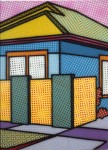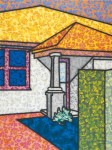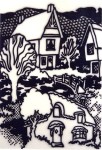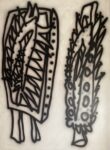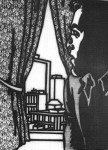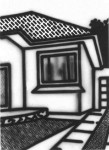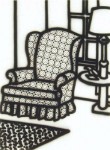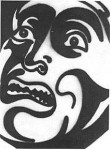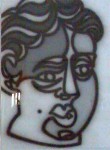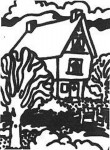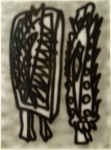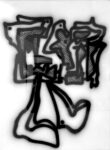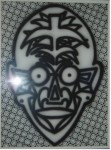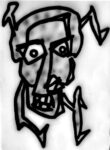1994
1994 Works
3D/Miscellaneous
Paintings

The success of this work is due in large part to Arkley’s ability to sustain the sweeping dark grey line, and areas of undifferentiated colour, on such an extensive scale.
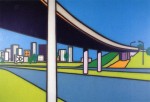
In this work, first exhibited in 1994, the subject is given a relatively warm and colourful character.
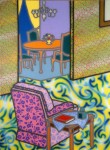
This painting reprises elements of Suparoom (1992), but in a more highly patterned and more spatially complex form.
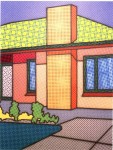
The main lines of the real estate source are transcribed over the reverberant, patterned surface in the manner typical of the ‘Pointillist Suburb’ series.
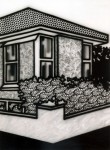
This elegant work, probably included in Arkley's solo exhibition at the Bellas Gallery in 1994, was recorded several times after the artist's death as 'Corner House.'
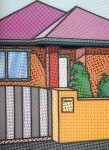
The effect of overlapping patterning is complicated here by the use of dark grey line-work, and an unusual pattern suggestive of metal security doors or window grilles.
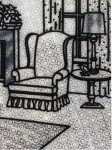
First shown in the Arkley exhibition at the Bellas Gallery, Brisbane, May 1994, this is an elegant example of Arkley’s sophisticated mid 1990s use of stencilling, here using an overall lace pattern.
This painting, exhibited in Brisbane and Hobart in 1994, now forms part of Icon Interior (1994-2001) [3/M].
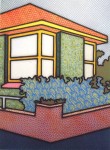
Based on the same composition Arkley used for Hedge on Street Corner (1988) and Untitled (1988) [Hedge], this work features extensive stencilled pattern and nuanced colour.
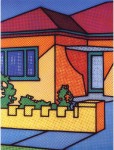
This painting is based on the same real estate source as A Splendid Superior Home (1989) and Stucco Home (1991).
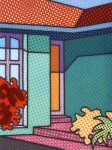
A classic example of Arkley’s use of the ‘moiré effect’ created by deliberately misaligned stencilled dot patterning.
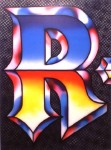
An Arkley oddity, exhibited in the 1994 ‘Pointillist Suburb’ show, based on a lettering sample in his studio collection.
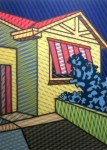
This painting, first shown in Arkley's ‘Pointillist Suburb’ exhibition, features criss-crossing line-work in various hues.
Works on Paper
Unidentified work on paper, probably monochrome, presumably based on the same composition as Brand New 1994.
Unidentified work on paper exhibited at both the Bellas Gallery, Brisbane, and the Dick Bett Gallery, Hobart, in 1994.
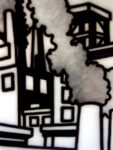
Work on paper auctioned in 2001, probably identical with the work exhibited with this title in 1994.

1994 was a year of high productivity for Arkley, and also notable stylistic development, apparent particularly in the ‘Pointillist Suburb’ show at Tolarno in November, where he applied stencilled pattern and colour to the suburban exterior with new subtlety and finesse. This show also introduced a new theme, the freeway, in two large canvases. For more extended comments on the key thematic and stylistic developments apparent in these works, see linked exhibition entry.
Other exhibitions included a solo show of black and white works at the Bellas Gallery in Brisbane.Arkley’s reputation as the contemporary painter of suburbia grew significantly during the year. Family Home: Suburban Exterior (1993) was shown in the McCaughey Prize at the NGV in Feb.-March, and then later in the year at Monash University, as one of the university’s major new acquisitions. Arkley himself participated in the growth of his profile as a chronicler of suburbia during the year, in prominent coverage in World Art, Polis, and the Melbourne Age (see bibliography for 1994 under Arkley, Crawford, and Harford respectively).O.Y.O. Flats (1987) featured on the invitation (reproduced here) and catalogue cover for the Sotheby’s auction in September; its sale attracted considerable media coverage (see e.g.Trioli 1994).
During the year, he embarked on two significant collaborative ventures with long-standing colleagues Juan Davila and Peter Tyndall. Icon Interior (1994-2001) [3/M], produced with Juan Davila, elaborated on their earlier cooperation on Blue Chip Instant Decorator: a Room (1991-2) [3/M] and various works on paper also made in 1991-2 (see above). The new project centred on a black and white canvas version of Arkley’s earlier Icon Head (1990), which Arkley gave to Davila with the instruction to ‘ruin’ it (see Gregory 2001, and Carnival 153-57). Left incomplete in 1994, this project was resumed by Davila after Arkley’s death, with the cooperation of Alison Burton (see main entry on this work, first exhibited in Canberra in 2002, and then in the Davila survey show held in 2006 in Sydney and Melbourne).
Later in 1994, Arkley began discussions with another fellow artist and friend of long standing, Peter Tyndall, about a collaborative scheme to be shown at Anna Schwartz’s Melbourne gallery in 1995. The project was to involve one or more canvases depicting one of Tyndall’s trademark 1950s-style families peering at an Arkley house.[1] Correspondence from Nov.1994 – Sept.1995, necessitated by their geographical separation (Tyndall lives in country Victoria), reveals the eventual breakdown of this project due to the incompatibility of the two artists’ working methods and personalities (see material in Arkley’s files, discussed in more detail in Carnival 139-40). The correspondence includes several preparatory sketches incorporating a reproduction of Arkley’s Light and Bright (1994). Terminating the arrangement in Sept.1995, Tyndall wrote that it was better to ‘ditch the project and save the friendship’; Arkley agreed, but was privately very taken aback by the whole incident. A photograph of an unfinished canvas from this project is preserved in Arkley’s archive.
1994 Exhibitions
‘Baillieu Myer Collection of the 80s’, MOMA at Heide, Feb.1994 [clipping in artist’s files]
- Suburban Interior (1983) (MOMA at Heide, Myer coll.)
‘John McCaughey Memorial Art Prize’, NGV, 3 Feb.-19 March 1994 (check-list in Arkley’s files)
- Family Home: Suburban Exterior (1993) (Monash Uni. collection: acquired 1994)
‘Howard Arkley’, Bellas, Brisbane, May- June 1994
– refer linked entry for full details
‘Love & Ruin: Art & St Kilda in the Twentieth Century’, St Kilda Town Hall, 26 June-21 July 1994
– {unidentified Arkley work/s}
‘Beyond the Surface’, Dick Bett Gallery, Hobart, Tasmania, 4-23 Aug.1994 (group show including a canvas and 6 works on paper by Arkley; copy of catalogue in artist’s files)
- 10. Tudor Village (1994) [W/P] (SPP on P, 76 x 56 [paper], priced at $1,100): NB illustrated in exh.cat.
- 11. Walking Abstract (1994) [W/P] (SPP on P, 76 x 56 [paper], priced at $1,100): unidentified; NB the title suggests a work similar to the box-on-legs in Happenstance (1987) and Pittoresque 1988 [W/P] (in fact the latter is roughly the same size); but this work was more probably monochrome, like the other works in the 1994 exhibition
- 12. Icon Head (1994) (SPP on C, 160 x 120, priced at $4,750): B&W canvas later incorporated into HA & Juan Davila’s installation Icon Interior (1994-2001) [3/M]
- 13. Face of an Icon (1994) [W/P] (SPP on P, 76 x 56 [paper], priced at $1,100): unidentified; presumably similar to Black and White Icon (1995) [W/P] (larger work shown at Tolarno 1995)
- 14. Twin propogation (1994) [W/P] (SPP on P, 76 x 56, $1,100): unidentified
- 15. Strange fruit (1994) [W/P] (SPP on P, 76 x 56 [paper], priced at $1,100)
- 16. Mask for Baudelaire (1994) [W/P] (SPP on P, 76 x 56 [paper], priced at $1,100): ill. in exh.cat.; presumably = work shown at Tolarno Sept.1995, cat.24 (as ‘Head Baudelaire’)
ACAF4: Fourth Australian Contemporary Art Fair, Exhibition Buildings, Melbourne, 29 Sept.-2 Oct.1994 (catalogue in Arkley’s files)
- Light & Bright (1994) [ill.in ACAF4 cat., p.103]
- (apparently) A Freeway Painting (Over Pass) (1994) [visible in archive photo taken at ACAF4, but not mentioned in the catalogue)
‘Howard Arkley: The Pointillist Suburb series’, Tolarno, Nov.- Dec. 1994
– refer linked entry for full details
‘Tableaux: Works from the Monash University Collection’, Monash University Gallery, 7 Nov.-1994-2 Feb.1995 (copies of catalogue/brochure & Age report in Arkley’s files)
- 1. Curvelinear 1978 (P/C Melb.[Harrison]): exh.as on loan from P/C
- 2. Arabesque 1979 [Curvilinear] (MUMA coll.)
- 3. Family Home: Suburban Exterior (1993) (MUMA coll.)
[1] For a survey of Tyndall’s work, typically titled A Person Looks At A Work Of Art / someone looks at something…, see Pamela Hansford, Peter Tyndall – Dagger Definitions, Richmond: Greenhouse, 1987.
